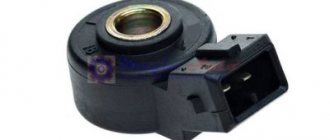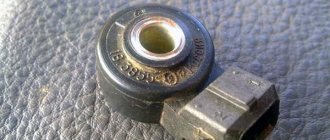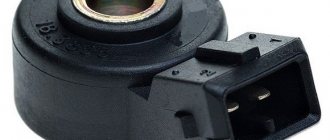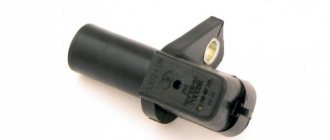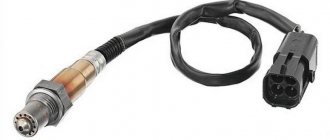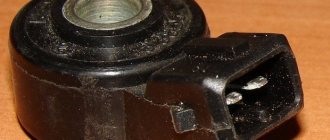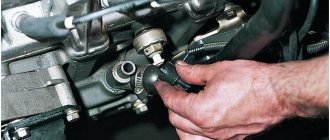Despite the fact that the car has a considerable number of installed sensors responsible for various parameters of its operation, only a few of them are of the greatest importance. These include the knock sensor of the VAZ 2114.
This device is used to record vibration (detonation) conditions of fuel during its direct combustion inside the engine. In addition, there is a constant transmission of data in the form of signals to the vehicle's ECU. As a result, the electronic unit adjusts (changes) the ignition timing. The importance of the device is due to the fact that if it fails or malfunctions, the ECU does not receive reliable data from it, and as a result, the detonation process is not damped.
The above circumstances have a destructive effect on the car engine. Therefore, negligence or failure to replace a part in a timely manner can destroy any motor. And this is not an exaggeration.
From this article you will learn why a knock sensor is needed, what problems may occur during its operation, and how to check and replace the sensor yourself.
Where is the knock sensor of the VAZ 2114
It is located between the second and third cylinders on the engine block (if viewed from the radiator side). Its location from the point of view of providing simple, unobstructed access is conveniently implemented in eight valve engines. But in more complex engines (16 valves), some inconvenience appears. This is due to the high density and accumulation of units in the engine compartment.
Tightening torques for brake system connections
| list of mechanisms and engine parts | Thread | Tightening torque of threaded connections, kgf/m |
| Wheel connection pins | Ml 2×1.25 | 6,5-9,3 |
| Wing for attaching the brake booster bracket to the body | M8 | 3,1-3,8 |
| Nuts securing the vacuum brake booster to the bracket | M10 | 2,7-3,2 |
| Clutch connecting the brake master cylinder to the vacuum booster | M10 | 2,7-3,2 |
| Front wheel brake hose end | M10xl,25 | 2,9-3,3 |
| Bolt for attaching the front wheel brake to the steering knuckle | M10xl,25 | 2,9 — 3 ,6 |
| Hardware for fastening the front brake working cylinder to the guide pins | M8 | 3,1-3,8 |
| Bolt connecting the front brake working cylinder to the caliper | M12xl,25 | 9,6-11,8 |
| Brake pipe fittings | M10 | 1,5-1,8 |
| Rear brake working cylinder fastening pin | M6 | 0,3-0,8 |
| Pressure regulator bracket attachment knob | M8 | 1-2,4 |
| Bolt connecting the pressure regulator to the bracket | M8 | 1-2,4 |
Most common faults
In fact, cases of failure of the detonation detection device itself are not so common. In most cases, the reasons for incorrect operation are auxiliary factors, such as:
- Damage to the wires connecting the control unit to the sensor. As a result, the unit does not read signals from the device; contamination of the metal part of the part;
- corrosion (as a result of environmental influences);
- chafing breaks and wires;
- oxidation of one or both contacts.
Less commonly, there is a complete failure of the internal piezo element (plate) of the device. In most cases, the sensor cannot be repaired, and the repair itself is not entirely rational in terms of effort, time and money. The surest way is to buy a new product; fortunately, it is not expensive.
Steering torques
| List of mechanisms and parts of the propulsion device | Thread | Tightening torque of threaded connections, kgf/m |
| Steering coupling | M8 | 1,5-1,9 |
| Steering column bracket attachment bolt | M8 | 1,5-1,9 |
| Bolt connecting the steering column bracket | M6 | Twist until the head comes off |
| Fastening hardware for fastening the lower flange of the steering shaft coupling | M8 | 2,2-2,7 |
| Steering wheel attachment knob | M16x1.5 | 3,1-5,1 |
| Rod coupling lock nut | M18x1.5 | 12,1-14,9 |
| Nut attaching ball pin | M12x1.25 | 2,7-3,3 |
| Bolt connecting the steering linkage to the rack | MIOxl | 7,0-8,6 |
| Steering gear bearing coupling | M38x1.5 | 4,5-5,5 |
Signs of malfunction of the knock sensor VAZ 2114
The knock sensor of the VAZ 2114 is a device on the serviceability of which the overall performance of the engine of the fourteenth depends. If the sensor fails, you will notice the following changes in the operation of the car:
- twitching of the internal combustion engine of the car;
- reduction in power indicators;
- an error appears on the instrument panel;
- increasing engine operating temperatures and rapid heating;
- increased fuel consumption;
- persistent smell of gasoline.
In order to understand the reason for the incorrect operation of the internal combustion engine, it is necessary to connect a diagnostic tool. Such a device allows you to read and display the code of a particular error. In our case, the following codes are distinguished: from 0325 to 0327 inclusive. All of them indicate that the sensor is not working properly.
Tightening torques for threaded connections in electrical equipment
| Name of devices and engine parts | Thread | Tightening torque of threaded connections, kgf/m |
| Nut of the bolt of the lower fastening of the generator | M10x1.25 | 6.0-7.4 |
| Hardware connecting the generator bracket | M10x1.25 | 2,3-5,3 |
| Lock nut for generator attachment bar | M 10×1.25 | 2.9-4.6 |
| Starter bolt | M8 | 0.7-1.6 |
| Battery connection coupling | M8 | 0.7-1.6 |
| Temperature indicator sensor | M14x1.5 | 0.9-1.5 |
| Emergency oil pressure sensor | M14x1.5 | 2,5-2,8 |
How much does a knock sensor cost for a VAZ 2114?
On VAZ 2114 cars of early production years there is a Lada sensor 21120385501001. It has an extremely low prevalence and because of this its price is high and amounts to 800-1300 rubles. The only commonly found analogue is General Motors 21120-3855010-01 with a cost of 1600-1800 rubles.
The original broadband DD has article number 21123855020. Its price is much lower and amounts to 100-160 rubles. Its good analogues are presented in the table.
Table - Good analogues of the original VAZ 2114 knock sensor
| Manufacturer | vendor code | Approximate cost, ruble |
| Fenox | SD10100O7 | 210-420 |
| Decaro | 2112-3855020 | 360-490 |
| Samara 2112 | 3855020 | 200-250 |
| Road map | 21123855020 | 260-380 |
| ERA | 550489 | 300-340 |
How to check the knock sensor of a VAZ 2114
Before replacing the knock sensor with a new product, there are several recommendations for checking its performance, as well as identifying the reasons for the incorrect operation of the device. If on 8 valve engines access to the product is quite free, then on sixteen valve engines you will have a little more difficulty. To check the functionality of the sensor itself, you can resort to two available methods:
- checking with a multimeter;
- Testing operation without removal.
How to check the knock sensor of a VAZ 2114 with a multimeter
To check the knock sensor of a VAZ 2114 with a multimeter, follow these steps:
- We dismantle the sensor (how to do this is written in the next section of the article);
- We connect the multimeter probes to the DD contacts (if it is two-contact), if it is single-contact, the first probe to the wire, the second to the device body;
- We switch the tester to voltmeter mode and set the upper measurement limit to 200 mV;
- Tap a screwdriver (or any metal object) on the sensor body;
- If the device is working properly, the multimeter will show voltage surges, the magnitude of which should be directly proportional to the force of the impact (this indicates that the device retains the ability to convert mechanical energy into alternating current). If the multimeter readings do not change, the DD does not work.
If you find out that the device itself is working properly, but DD errors are displayed on the on-board computer or the car is not working as it should, the problem is most likely in the oxidized contacts of the sensor. Treat them with WD-40 or a similar solvent, install the DD in place and check the result. If that doesn't help, replace the knock sensor.
How to check the VAZ 2114 knock sensor without removing it
The second method, without removing the knock sensor on the VAZ 2114, is as follows. First, you must start the car engine and maintain its speed in the range from one and a half thousand to two thousand.
At the same time, you need to find the sensor and freely reach it. After that, take a convenient metal tool or device, knock on the part several times with increasing force (the main thing is not to overdo it). If the device is in good working order, the engine speed should increase when tapping (remember the principle of both operation and adjustment by the ECU). If after tapping no reaction occurs, you should dismantle the sensor and check it thoroughly with the same multimeter.
In any case, it is recommended to carry out a visual inspection of the product itself and pay attention to the following features:
- tightness of sensor mounting and connection;
- the degree of corrosion and contamination on the device body;
- contact connection (over time it may oxidize and partially or completely lose conductivity).
OPERATING PRINCIPLE AND FUNCTIONAL PURPOSE
Let's figure out what a knock sensor is used for using its typical operating cycle as an example.
When the engine is operating in normal mode, the DD, roughly speaking, sleeps. However, when detonation begins to occur inside the cylinder block, the sensor reacts to its power and sends a corresponding signal to the ECU. Based on the information received, the controller changes the ignition angle until detonation in the fuel combustion chambers disappears.
What does the knock sensor of the VAZ 2114 affect? Without it, the electronics of the fourteenth cannot set the correct ignition timing, which threatens engine malfunctions: if the timing is smaller than necessary, as a result of micro-explosions, the engine will not be able to produce its usual power, and the valves in the cylinders will wear out quickly. More than necessary - gasoline consumption will increase, acceleration dynamics will decrease, and the engine itself will constantly overheat.
The operating principle of the knock sensor is based on piezoelectric effect technology. Inside the metal body of the device there is a plate that is highly sensitive to the force of mechanical influences exerted on it.
The device is the simplest
When detonation occurs in the engine, vibration is transmitted to the plate, which is converted by the sensor from mechanical energy to alternating current. The power of the generated current depends on the strength of the shock applied to the sensor.
There are two types of DD installed on the VAZ 2114 - broadband and resonant.
- The VAZ resonant knock sensor has a cylindrical shape. It is sensitive only to micro-explosions whose power is above a certain level;
- Broadband devices, on the contrary, are sensitive to all vibrations occurring in the engine, information about which they transmit to the ECU, and the electronics, based on the magnitude of the received alternating voltage, themselves determine whether detonation has occurred in the engine.
Resonant and broadband devices are not interchangeable, so if replacement is necessary, carefully select a new DD.
The cost of a new DD varies from 250 to 700 rubles for sensors of any type. We do not recommend taking domestically produced devices, since reviews from owners of fourteenth devices indicate that they have an extremely low working life. Moreover, under the guise of DD, ordinary dummies in an identical body, but without any functional filling, are often sold.
The best option is sensors produced by the German company Bosch; they cost almost 2 times more than the original VAZ ones, but at the same time they last much longer and work without problems. Also on the fourteenth you can install a VAZ 2115 knock sensor and devices for GAZ cars (article 18.3855), their mounting sockets are completely similar.
Knock sensor VAZ 2114 bosch
Replacing the knock sensor on a VAZ 2114 - step-by-step instructions
Replacing the DD is an extremely simple process. You can change the knock sensor of a VAZ 2114 within 5 minutes; for this you only need a 20 or 13 socket wrench (depending on what specific type of sensor is installed on your fourteenth).
So, after receiving a large block of theoretical information, we will proceed to practical exercises and thoroughly analyze the entire process of replacing (removing) the sensor.
Instructions for 8 valve engine
To perform the work you will need a 13mm wrench or socket.
- We gain free access and unscrew the fastening nut.
- Then disconnect the contact wires from the device connector.
- We extract the part.
Reinstallation is carried out in the opposite sequence. Everything is quite simple.
Instructions for engine 16 valves VAZ 2114
We use the same tools as in the first case. The only addition is the need to remove the internal combustion engine protection and ensure a convenient position and access under the bottom of the car. To do this, you can place the car on an overpass or repair pit. The removal and installation process is similar to the first example.
Tightening torques for rear suspension threaded connections
| Name of devices and propulsion parts | Thread | Tightening torque of threaded connections, kgf/m |
| Wheel attachment hardware | M12x1.25 | 6.7-9,5 |
| Rear Wheel Bearing Clutch | M20x1.5 | 19,0-23,0 |
| Lower bolt nut connecting the shock absorber to the rear suspension arm | M12x1.25 | 6,8-8,4 |
| Wing for fastening the rear suspension shock absorber rod to the body | M10x1.25 | 5,1-6,3 |
| Locknuts for hardware attaching the rear suspension arm to the bracket | M12x1.25 | 6,8-8,4 |
| Clutch connecting the rear suspension arm bracket to the body | MKM.25 | 2,8-3,5 |
Useful tips
Recently, cases of selling defective spare parts and sensors without the necessary internal contents have become more frequent. Therefore, immediately after purchasing the product you need, it is recommended to check its performance with a multimeter. You should know that on older VAZ 2114 models the knock sensor (resonant) differs from modern products (broadband) in price, design features and operating principles. Therefore, you should buy a product that is designed specifically for your car model. A device with a resonant type of operation cannot be replaced by modern products without modifying the ECU.
